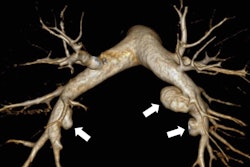 Prof. Sahar Saleem of Kasr Al Ainy Hospital of Cairo University.
Prof. Sahar Saleem of Kasr Al Ainy Hospital of Cairo University.
Egyptian researchers have used CT imaging to "virtually dissect" a mummified woman from the country's New Kingdom era who died 3,500 years ago, named the "Screaming Woman" for her contorted, open mouth.
 Full view of the "Screaming Woman" mummy. All images courtesy of Prof. Sahar Saleem.
Full view of the "Screaming Woman" mummy. All images courtesy of Prof. Sahar Saleem.
The woman's expression may have been due to cadaveric spasm, which is associated with dying in pain or "intense emotional distress," reported a team led by Prof. Sahar Saleem, professor of radiology at Kasr Al Ainy Hospital of Cairo University. She and colleague Samia El-Merghani, PhD, of Egypt's Ministry of Tourism and Antiquities in Cairo published their findings on 2 August in Frontiers in Medicine.
The mummy was found in 1935 during an archeological expedition led by the Metropolitan Museum of New York to Deir Elbahari, near Luxor, the site of ancient Thebes. The archeological team excavated the tomb of Senmut, an architect and supposed lover of Queen Hatschepsut (who reigned from 1479 to 1458 BCE). Under the tomb, the researchers discovered a separate burial chamber for Senmut's mother, Hat-Nufer, and other relatives.
The archeologists also found in this separate chamber a wooden coffin containing a woman wearing a black wig and two scarab rings in silver and gold. Her expression was striking, with her mouth wide as if in a scream. Saleem and El-Merghani noted that the woman had been embalmed with costly materials, suggesting that her appearance was caused by pain rather than poor embalming.
The mummy remained at Kasr Al Ainy School of Medicine until 1998 before it was moved to the Cairo Egyptian Museum. The woman's coffin and rings have been on display at the Metropolitan Museum of New York since 1935.
Saleem used CT imaging to "virtually dissect" the mummified woman. The authors also used scanning electron microscopy (SEM), Fourier transform infrared spectroscopy (FTIR), and x-ray diffraction analysis (XRD) to classify materials related to the body.
When found, the mummy was unwrapped, lying supine with her hands folded above her groin. Saleem estimated that the woman had been just over five feet tall, about 48 years old, and had suffered from mild arthritis in the spine. Her organs remained, which was a surprise, since the typical method of mummification at the time included the removal of the lungs, liver, spleen, kidneys, and intestine.
The woman had been embalmed with juniper and frankincense imported from the Eastern Mediterranean and East Africa or Southern Arabia, and her hair had been dyed with henna and juniper; she also wore a wig made from date palm fibers treated with quartz, magnetite, and albite crystals to give it the black color that represented youth in Egyptian society at the time. Saleem and El-Merghani found no obvious cause of death.
 CT of the "Screaming Woman" mummy visualizes both front and back of the wig.
CT of the "Screaming Woman" mummy visualizes both front and back of the wig.
What caused the woman's expression? Perhaps a rare form of muscular stiffening called cadaveric spasm, which is associated with violent death and intense emotion, Saleem and El-Merghani explained. The fact that the materials used to embalm her were costly prompted them to hypothesize that her scream was caused by physical anguish rather than a careless mummification process.
 CT shows the brain inside the skull of the "Screaming Woman" mummy.
CT shows the brain inside the skull of the "Screaming Woman" mummy.
"The mummy's screaming facial expression in this study could be read as a cadaveric spasm, implying that the woman died screaming from agony or pain," Saleem said in a statement released by the journal.
The mummy sheds light on ancient Egyptian mummification practices, Saleem noted.
"This mummified Screaming Woman is a true 'time capsule' of the way that she died, revealing some of the secrets of mummifications," she said.
The complete report can be found here.




















